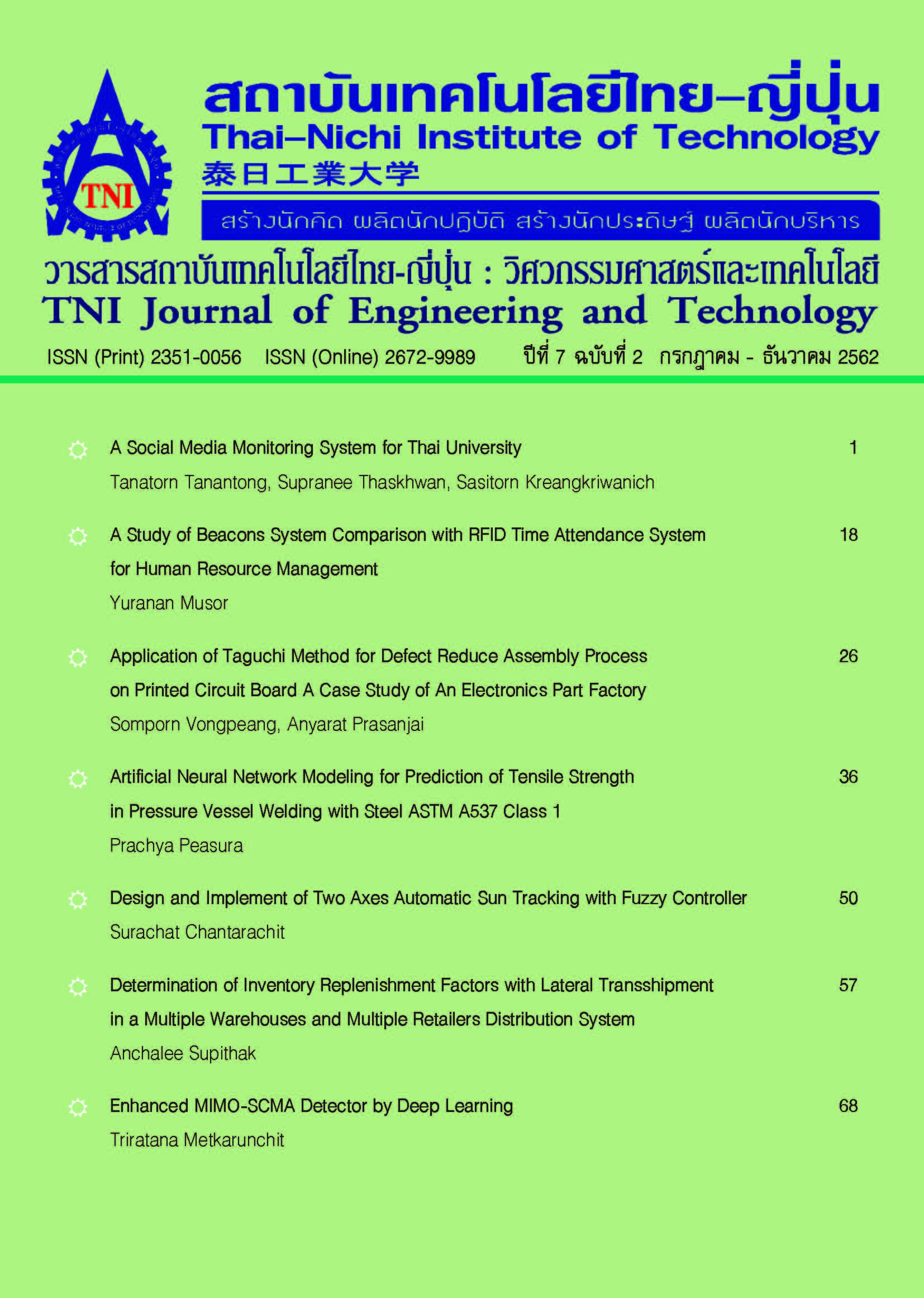Unfolding to the Past: Temporal and Dimensional Perception Enrichment for Image Impression Improvement
Main Article Content
บทคัดย่อ
An image is in essence a record of visible objects at a particular point in time. This paper proposes a method based on adaptively integrating depth cues with relative motion for enriching temporal and dimensional perception of images. The key idea of our method is to construct a natural-looking animated sequence of images from the original one by introducing differing depth cues and varying time frames to individual generated images. The differing depth cues are created by utilizing variations of visual details and color saturation, whereas the presentation time duration of each image is determined based on structural similarity of consecutive images. The resulting animated image can give a sense of increasing depth as well as a temporal dynamics from past to present. The proposed method can be applied to image impression improvement, especially in the exhibitions or presentations of historical places and artifacts.
Article Details
นโยบายการรับบทความ
กองบรรณาธิการวารสารสถาบันเทคโนโลยีไทย-ญี่ปุ่น มีความยินดีรับบทความจากอาจารย์ประจำ และผู้ทรงคุณวุฒิในสาขาวิศวกรรมศาสตร์และเทคโนโลยี ที่เขียนเป็นภาษาไทยหรือภาษาอังกฤษ ซึ่งผลงานวิชาการที่ส่งมาขอตีพิมพ์ต้องไม่เคยเผยแพร่ในสิ่งพิมพ์อื่นใดมาก่อน และต้องไม่อยู่ในระหว่างการพิจารณาของวารสารอื่นที่นำส่ง ดังนั้นผู้สนใจที่จะร่วมเผยแพร่ผลงานและความรู้ที่ศึกษามาสามารถนำส่งบทความได้ที่กองบรรณาธิการเพื่อเสนอต่อคณะกรรมการกลั่นกรองบทความพิจารณาจัดพิมพ์ในวารสารต่อไป ทั้งนี้บทความที่สามารถเผยแพร่ได้ประกอบด้วยบทความวิจัย ผู้สนใจสามารถศึกษาและจัดเตรียมบทความจากคำแนะนำสำหรับผู้เขียนบทความ
การละเมิดลิขสิทธิ์ถือเป็นความรับผิดชอบของผู้ส่งบทความโดยตรง บทความที่ได้รับการตีพิมพ์ต้องผ่านการพิจารณากลั่นกรองคุณภาพจากผู้ทรงคุณวุฒิและได้รับความเห็นชอบจากกองบรรณาธิการ
ข้อความที่ปรากฏภายในบทความของแต่ละบทความที่ตีพิมพ์ในวารสารวิชาการเล่มนี้ เป็น ความคิดเห็นส่วนตัวของผู้เขียนแต่ละท่าน ไม่เกี่ยวข้องกับสถาบันเทคโนโลยีไทย-ญี่ปุ่น และคณาจารย์ท่านอื่น ๆ ในสถาบัน แต่อย่างใด ความรับผิดชอบด้านเนื้อหาและการตรวจร่างบทความแต่ละบทความเป็นของผู้เขียนแต่ละท่าน หากมีความผิดพลาดใด ๆ ผู้เขียนแต่ละท่านจะต้องรับผิดชอบบทความของตนเองแต่ผู้เดียว
กองบรรณาธิการขอสงวนสิทธิ์มิให้นำเนื้อหา ทัศนะ หรือข้อคิดเห็นใด ๆ ของบทความในวารสารสถาบันเทคโนโลยีไทย-ญี่ปุ่น ไปเผยแพร่ก่อนได้รับอนุญาตจากผู้นิพนธ์ อย่างเป็นลายลักษณ์อักษร ผลงานที่ได้รับการตีพิมพ์ถือเป็นลิขสิทธิ์ของวารสารสถาบันเทคโนโลยีไทย-ญี่ปุ่น
ผู้ประสงค์จะส่งบทความเพื่อตีพิมพ์ในวารสารวิชาการ สถาบันเทคโนโลยีไทย-ญี่ปุ่น สามารถส่ง Online ที่ https://www.tci-thaijo.org/index.php/TNIJournal/ โปรดสมัครสมาชิก (Register) โดยกรอกรายละเอียดให้ครบถ้วนหากต้องการสอบถามข้อมูลเพิ่มเติมที่
- กองบรรณาธิการ วารสารสถาบันเทคโนโลยีไทย-ญี่ปุ่น
- ฝ่ายวิจัยและนวัตกรรม สถาบันเทคโนโลยีไทย-ญี่ปุ่น
เลขที่ 1771/1 สถาบันเทคโนโลยีไทย-ญี่ปุ่น ซอยพัฒนาการ 37-39 ถนนพัฒนาการ แขวงสวนหลวง เขตสวนหลวง กรุงเทพมหานคร 10250 ติดต่อกับคุณพิมพ์รต พิพัฒนกุล (02) 763-2752 , คุณจุฑามาศ ประสพสันติ์ (02) 763-2600 Ext. 2402 Fax. (02) 763-2754 หรือ E-mail: JEDT@tni.ac.th
References
[2] Canva. (2019). [Online]. Available: https://www.canva. com/features/photo-effects/
[3] BeFunky. (2019). [Online]. Available: https://www.befun ky.com/features/photo-effects/
[4] L. Wang. “8 mind-bending optical illusions (and what they reveal about how our brains work).” Visual Learning Center by Visme. https://visme.co/blog/best-optical-illusions/ (accessed Sep. 3, 2019).
[5] A. Hosny. “How come a 3D movie on a 2D screen ?!” https://abdelrahmanhosny.wordpress.com/2014/03/12/ how-come-a-3d-movie-on-a-2d-screen/ (accessed Sep. 3, 2019).
[6] C. Jirousek. “Two dimensional illusion of three dimensional form.” Art, Design, and Visual Thinking. http://char.txa.cornell.edu/language/element/form/form illu.htm (accessed Sep. 3, 2019).
[7] J.-I. Jung, J.-H. Lee, I.-Y. Shin, J.-H. Moon, and Y.-S. Ho, “Improved depth perception of single-view images,” ECTI Transactions on Electrical Eng., Electronics, and Communications, Vol. 8, No. 2, pp. 164-172, Aug. 2010.
[8] K. Ruxpaitoon, N. Aoki, and H. Kobayashi, “Studies on perspective expression technique used in wall paintings of each Thai dynasty period,” Journal of the Society of Photographic Science and Technology of Japan, Vol. 76, No.1, pp. 88-98, 2013.
[9] D. Scott. “Chiaroscuro.” https://drawpaintacademy.com/ chiaroscuro/ (accessed Sep. 3, 2019).
[10] J. Qian, J. Li, K. Wang, S. Liu, and Q. Lei, “Evidence for the effect of depth on visual working memory,” Scientific Reports, Jul. 2017.
[11] P. B. Hibbard, A. E. Haines, and R. L. Hornsey, “Magnitude, precision, and realism of depth perception in stereoscopic vision,” Cognitive Research: Principles and Implications, May 2017.
[12] P. Cammack and J. M. Harris, “Depth perception in disparity-defined objects: finding the balance between averaging and segregation,” Philosophical Transactions of the Royal Society B: Biological Sciences, Jun. 2016.
[13] Lars. “4 tips for modern vintage photography.” https://www.eyeem.com/blog/modern-vintage-photo graphy (accessed Sep. 3, 2019).
[14] A. Semmo, M. Reimann, M. Klingbeil, S. Shekhar, M. Trapp, and J. Döllner, “ViVid: Depicting dynamics in stylized live photos,” 2019, doi: 10.1145/3305365.3329726.
[15] Bloggif. (2019). [Online]. Available: https://en.bloggif.com/ effect (accessed Sep. 3, 2019).
[16] F. Q. Wei. “Time in motion by Fong Qi Wei.” Gestalten. https://gestalten.com/blogs/journal/time-in-motion-by-fong-qi-wei (accessed Sep. 3, 2019).
[17] fqwimages. https://fqwimages.tumblr.com/ (accessed Sep. 3, 2019).
[18] fqwimages. “Time paintings.” https://fqwimages.com/ time-paintings/ (accessed Sep. 3, 2019).
[19] The MathWorks, Inc. “Reduce the number of colors in an image.” https://www.mathworks.com/help/images/ reduce-the-number-of-colors-in-an-image.html (accessed Sep. 3, 2019).
[20] R. W. Floyd and L. Steinberg, “An adaptive algorithm for spatial gray scale,” International Symposium Digest of Technical Papers, Society for Information Displays, 1975, pp. 36.
[21] Z. Wang. “Image quality assessment: From error visibility to structural similarity.” https://pdfs.semanticscholar.org/ 66dc/7d32429e5e5906d1026706eb3a716b67bd3b.pdf (accessed Sep. 3, 2019).
[22] I. Mamun. “Image classification using SSIM.” https:// towardsdatascience.com/image-classification-using-ssim-34e549ec6e12 (accessed Sep. 3, 2019).
[23] The MathWorks, Inc. “ssim.” https://www.mathworks. com/help/images/ref/ssim.html (accessed Sep. 3, 2019)

